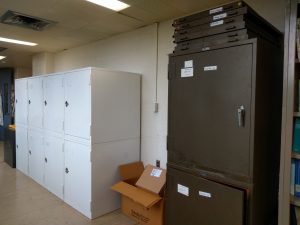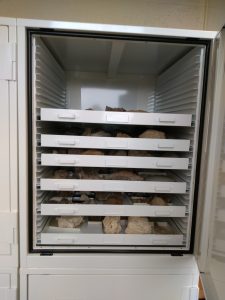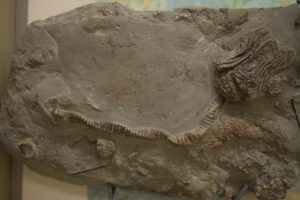
Crinoid specimen in the Joe Webb Peoples Museum (donated by Henry I Nettleton).
Over the last few weeks, a second step in the dramatic reorganization of Wesleyan’s natural history collections has been undertaken. The old cabinets housing an extensive array of minerals, fossils and archaeological and ethnological specimens were falling into disrepair. With the green paint peeling, the doors warped and unable to close on their linings of disintegrating foam insulation, these cabinets, in some sense fossils themselves, were nowhere near fit to effectively protect the artifacts in their care. Proper storage of paleontological specimens is vital for their long-term preservation and usefulness. The old cabinets are demonstrably inappropriate for the storage of our valuable, sometimes fragile, collections of ancient materials, so it’s time for a change.
The replacement was started last year (summer 2018), when the 6 cabinets in the Joe Webb Peoples Museum itself (4th Floor Exley) were replaced. This year we went much further, replacing all 12 cabinets in the hallway of the 4th Floor of Exley, and during the replacement – to some extent -reorganized fossils in the 3d and 4th floor cabinets to better reflect the nature of the collections scientifically.
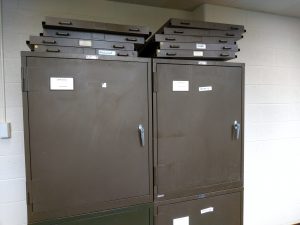
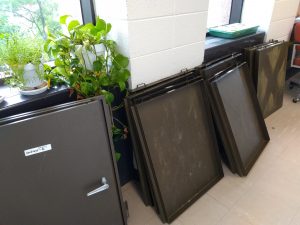
The goals of any particular collection of cultural or historical artifacts and its management differ widely depending on content, resources, and intent of the organization hosting the collections, but the foundational aims remain. Arguably most important are the compound tasks of mediating public access to the collection (e.g., through exhibits) and making the stored information available to researchers (e.g. in publicly available databases). These objectives require investment in the future of the collections through educational outreach that may pique the interest of students and non-scientists, and through positioning the materials as potential evidence, data that could help solve problems or answer questions. These objectives rely on the preservation of the collection under adequate conditions, ones that will ensure their continuing existence, so that they can be used in scientific research, projects and instruction.
The role of museum collections gets situated between these three points of interest, and the balance between them. If collections are improperly preserved, they may not be available to aid an interested party, be it experts in the field or Wesleyan students looking for questions and answers. The integrity of the materials and information we collect and keep about the past is essential for the scientific processes of research and education.
When we ask questions, we change and expand the circumstances that necessitate our inquiry—a natural history collection is an excellent example of something that builds on itself as it is used and interacted with.
In the sifting and sorting of specimens in drawers and cabinets, while becoming covered in green dust, I have been pushed to think about the meaning of fossils on multiple levels. ‘Where did this come from?’ and ‘Why is it broken into pieces?’ is just as interesting as speculating as to the evolutionary lineage of a particular sea lily (Crinoid)- of which we have a beautiful collection available from the famous locality of Crawfordsville (IN).
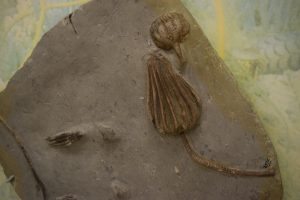
Crinoid specimens in the Joe Webb Peoples Museum (donated by Henry I Nettleton).
I have been amazed by the scope of what has been accumulated and combined in storage and on display, a staggering mass of shapes and sizes, colors and textures, organized into relative situation by the interconnectedness of their stories, even if disorganized in some ways physically.
An active engagement in the wealth of these collections is mutually beneficial, both for the communities that use and enjoy them, and for the materials themselves, which become newly relevant by inclusion in forensic or philosophical investigation = as new stories continue to be told. This relationship of mutuality is reason enough to support steps towards upgrading Wesleyan’s collections’ storage situation.
As a non-scientist, I find myself able appreciate the necessity of the shift, despite bringing a very different context to the table. I would guess it has something to do with the mystery and the possibility that’s felt in spaces that house the fascinating beauty of our Earth and the history of its life, this strange allure that pushes us to keep questioning what we know, but you’ll have to check it out for yourself.
